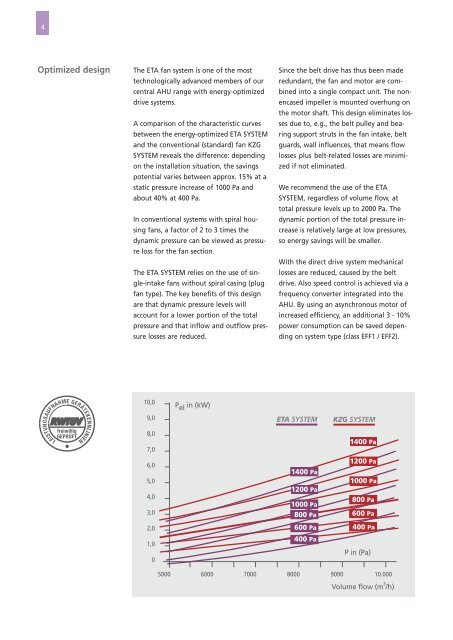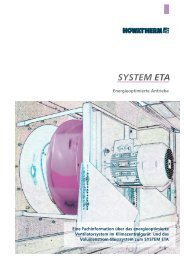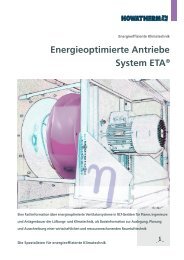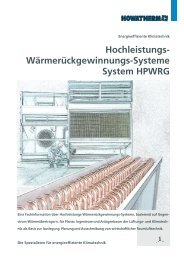RZ eta-engl Kopie - HOWATHERM
RZ eta-engl Kopie - HOWATHERM
RZ eta-engl Kopie - HOWATHERM
Create successful ePaper yourself
Turn your PDF publications into a flip-book with our unique Google optimized e-Paper software.
4<br />
Optimized design<br />
The ETA fan system is one of the most<br />
technologically advanced members of our<br />
central AHU range with energy-optimized<br />
drive systems.<br />
A comparison of the characteristic curves<br />
between the energy-optimized ETA SYSTEM<br />
and the conventional (standard) fan KZG<br />
SYSTEM reveals the difference: depending<br />
on the installation situation, the savings<br />
potential varies between approx. 15% at a<br />
static pressure increase of 1000 Pa and<br />
about 40% at 400 Pa.<br />
In conventional systems with spiral housing<br />
fans, a factor of 2 to 3 times the<br />
dynamic pressure can be viewed as pressure<br />
loss for the fan section.<br />
The ETA SYSTEM relies on the use of single-intake<br />
fans without spiral casing (plug<br />
fan type). The key benefits of this design<br />
are that dynamic pressure levels will<br />
account for a lower portion of the total<br />
pressure and that inflow and outflow pressure<br />
losses are reduced.<br />
Since the belt drive has thus been made<br />
redundant, the fan and motor are combined<br />
into a single compact unit. The nonencased<br />
impeller is mounted overhung on<br />
the motor shaft. This design eliminates losses<br />
due to, e.g., the belt pulley and bearing<br />
support struts in the fan intake, belt<br />
guards, wall influences, that means flow<br />
losses plus belt-related losses are minimized<br />
if not eliminated.<br />
We recommend the use of the ETA<br />
SYSTEM, regardless of volume flow, at<br />
total pressure levels up to 2000 Pa. The<br />
dynamic portion of the total pressure increase<br />
is relatively large at low pressures,<br />
so energy savings will be smaller.<br />
With the direct drive system mechanical<br />
losses are reduced, caused by the belt<br />
drive. Also speed control is achieved via a<br />
frequency converter integrated into the<br />
AHU. By using an asynchronous motor of<br />
increased efficiency, an additional 3 - 10%<br />
power consumption can be saved depending<br />
on system type (class EFF1 / EFF2).






